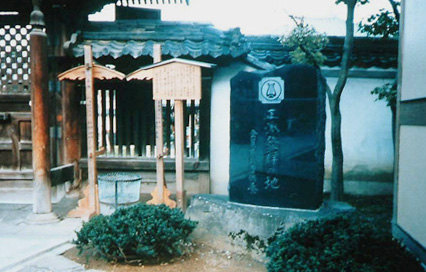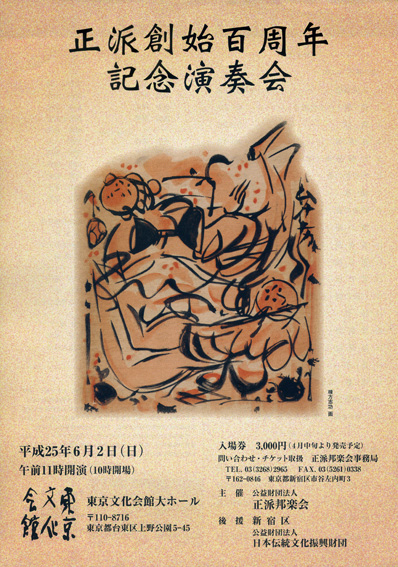![]()
Seiha hōgaku-kai / Historical Background / The Structure of the Seiha hōgaku-kai
![]()

![]()
Seiha hōgaku-kai
The Seiha hōgaku-kai is also recognised as a Public Interest Incorporated Foundation.
Initially licensed as an incorporated foundation in 1956, the Ministry of Education, Culture, Sports, Science, and Technology re-licensed the school in 2012. The largest organisation of koto performers, the school continues to pioneer modern Japanese music in contemporary society. Presently, there are ten chapters in Japan and one in the United States with over 18,000 members all of who promote koto music through teaching, performance, and other activities.
Nakashima Utashito (1896-1979), the first head of the school established the school in 1913 in Nagano City. The Seiha hōgaku-kai was the first school of koto music to emphasise the ability to read published music scores and an understanding of music theory as part of their pedagogy, which was then tested in an examination for professional status. The school has accordingly produced many extremely fine performers and educators.
2 June 2013, an immense concert with over one thousand performers was held at the Tokyo Bunka Kaikan Hall in Tokyo to celebrate the centennial of the Seiha hōgaku-kai.![]()

![]()
Historical Background
1913 (Taishō 2): With the sanction of Ōmiya Chiei (1885-1984), the daihongan high priest of the Zenkō-ji Temple in Nagano, Nakashima Utashito established the Seiha hōgaku-kai on 21 March, 1913.
1918 (Taishō 7): The publication of Seiha sōkyoku gakufu scores begins.
1920 (Taishō 9): The Seiha school relocated to Tokyo.
1923 (Taishō 12): A board of councillors is established with their first meeting in Ueda, Nagano Prefecture.
1924 (Taishō 13): The first examination for licensed koto instruction was held in Ueda, Nagano Prefecture.
1925 (Taishō 14): The publication of Seiha scores was shifted to Maekawa Printing unlimited in Osaka, where it remains.
1932 (Shōwa 7): The first performance of Seiha shōka was held at the concert celebrating the 20th anniversary of the Seiha hōgaku-kai. Saijō Yaso (1892-1970) wrote the text, and Nakashima Utashito composed the music.
1956 (Shōwa 31): 8 September, Ministry of Education authorization the Seiha hōgaku-kai establishment Foundation.
1965 (Shōwa 40): Nakashima Utashito and others erect a monument on the grounds of the Yasaka Shrine in Yamaguchi City commemorating the establishment of kumiuta , the musical genre marking the beginning of contemporary koto practice.
1969 (Shōwa 44): The licensed koto instruction examination is held for the first time in Los Angeles, California, U.S.A. .
1974 (Shōwa 49): The construction of the Seiha hōgaku kaikan is completed.
1978 (Shōwa 53): A memorial stele commemorating the establishment of the Seiha hōgaku-kai is erected on the grounds of the Zenkō-ji Temple in Nagano City.
1979 (Shōwa 54): The first iemoto, Nakashima Utashito, passed, and Nakashima Yasuko assumes the title of iemoto.
1996 (Heisei 8): The licensed koto instruction examination is held for the first time in Sao Paolo, Brazil.
2012 (Heisei 24): The Ministry of Education designates the Seiha hōgaku-kai as a public Interest Incorporated Foundation.
2013 (Heisei 25): On 2 June, the Seiha hōgaku-kai celebrated its centennial at the Tokyo Bunka Kaikan Hall.![]()

![]()
The Structure of the Seiha hōgaku-kai
![]()
Officers:
![]()
Board Chairman:
Okuda Kazuko
Vice Chairman:
Managing Director:
Yuize Tomoko
Managing Director:
Okuda Satoshi
Directors:
Sogawa Nobuko
Kawasaki Masako
Itō Takako
Tamura Kyōko
Obase Junko
Koishi Miwako
Asanuma Toshiko
Supervisors:
Kurogōchi Michiyo
Shimotori Kyōko
Yamamoto Syūya
Councilors:
Tanigaito Kazuko
Moroi Makiko
Miyazaki Kanako
Takahashi Toyoko
Watanabe Kuniko
Muramatsu Kyōko
Uno Fumie
Ichihashi Yuji
Iijima Kazuhiko
![]()
![]()
![]()

